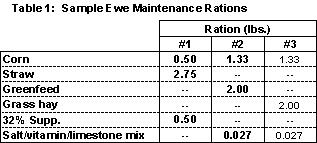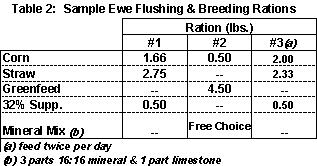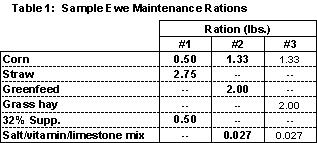| | Can I feed my sheep corn? The quick answer is - yes. While barley is the mainstay of Alberta sheep rations, corn is fed extensively in eastern Canada and the US Midwest. Corn has an as fed DE (digestible energy) of 3.39 Mcal/kg compared to barley with an as fed DE of 3.35 Mcal/kg - so, fairly similar energy levels. Protein levels in corn average 9% (as fed) and while Alberta barley averages 11% (as fed).
Corn, usually steam rolled or cracked, has long been a component of commercial sheep and lamb rations. Feed companies buy their ration ingredients based on what the ingredient contributes to the ration and on how much the ingredient costs. When corn is plentiful and cheap - it works.
However, due to higher cost and lack of availability not many Alberta producers feed straight corn to sheep. Because they are not familiar with the corn, producers have concerns about feeding it to their sheep. While barley is easier to find in Alberta and simpler to use than corn, sheep producers who find corn at a competitive cost can build sheep and lamb rations with it.
General recommendations for feeding corn:
- Always feed whole. Corn digests more slowly than barley and if it is fed whole there is less risk of acidosis (grain overload). Lamb creep rations occasionally use steam-rolled corn.
- If you feed 1 pound of barley - feed 1 pound of whole corn.
- Always start any new feed slowly. Feed very little grain for the first couple of days, slowly increase levels over ten days to two weeks. A ruminant's microbial population adjusts to changes in the amount of concentrates being fed, but not fast, they need time.
- Ewes can be fed up to 2 pounds of corn per day without problems - like any grain it is best to feed in two smaller feedings rather than all at once. Bossy ewes easily get acidosis by shoving out smaller ewes and eating more than their share of the grain.
- For ewes getting forage of 9-10% CP (crude protein), whole corn can be fed without a protein supplement. Rations during late pregnancy or lactation may need protein supplementation, depending on forage quality.
- Growing lambs need a protein supplement when fed corn.
Sample rations using corn
These are sample rations only - you should test all feeds and formulate rations based on actual ingredients. The SheepBytes ration balancer software can be used to develop balanced rations using corn. For advice talk to a feed company nutritionist where you buy flock supplements.
Ewe (Av. - 175 LB.) maintenance
This ration (Table 1) is to maintain body condition score and weight. It can be used for corral feeding to replace pasture. The grain is used to reduce the amount of forage required. Forage is needed by breeding ewes to maintain rumen health and function. Crops harvested as forage in a drought or when more mature are higher in fibre and can be lower in nutrients than regular greenfeed. These sample rations are to conserve forage supplies. It is possible to feed more forage and less, or no, grain. Again - be safe, feed test.

The salt / limestone / vitamin mix is 37% salt, 57% limestone and 6% AD&E (single strength Vitamin A with 10,000,000 IU / kg). OR To mix 100 pounds use 37 pounds salt, 57 pounds of limestone and 6 pounds of the correct vitamin premix. (Be aware that there are other vitamin A concentrations, you want the single strength.)
Ewes (Av. - 175 LB.) flushing & breeding
Ewes that are leaner than body condition score 3.0 are going to need flushing before breeding. If ewes are very thin, the normal flushing period of two to three weeks will have to be increased to four to six weeks.
To get ewes to gain weight for breeding, the maintenance diet has to change. The ewes require a higher dry matter (DM) intake - they need more feed to gain weight. They also require a higher digestible energy (DE) level - they need more energy, which is why grain is used for flushing. If you normally flush on pasture, or hay, and grain you can substitute corn for barley. If you feed ½ pound of barley to flush - feed the same amount of whole corn.
If you are dry-lot feeding your ewes for flushing, here are a couple of sample rations. Again - testing all your feeds will save you money.

These diets are pushing the allowable limit for straw. There can be a huge difference between what you feed a sheep and what they eat. Sheep don't really like straw if they have a choice and just because it's in their feedbunk does not mean they will, or can, eat it. Monitor what feed is left over, then decide if you need to make some ration changes. If the ewes do not increase body condition score, grain levels need to be increased.
Feeder lambs
These are total mixed rations (TMR) for 100 pounds of mixed feed. Keep self-feeders full at all times. Blend new batches with old ones rather than making abrupt ration changes. If you hand feed your lambs, supply a free choice mix of ½ salt and ½ limestone to provide calcium and to reduce urinary calculi. The protein supplement listed is soybean meal with a protein level of 44%. You can use other protein supplements - 34% CP canola meal or 32% supplement - but will have to increase supplement level. Consult your feed company nutritionist.

For more information contact:
Alberta Ag-Info Centre at 1-866-882-7677
|
|